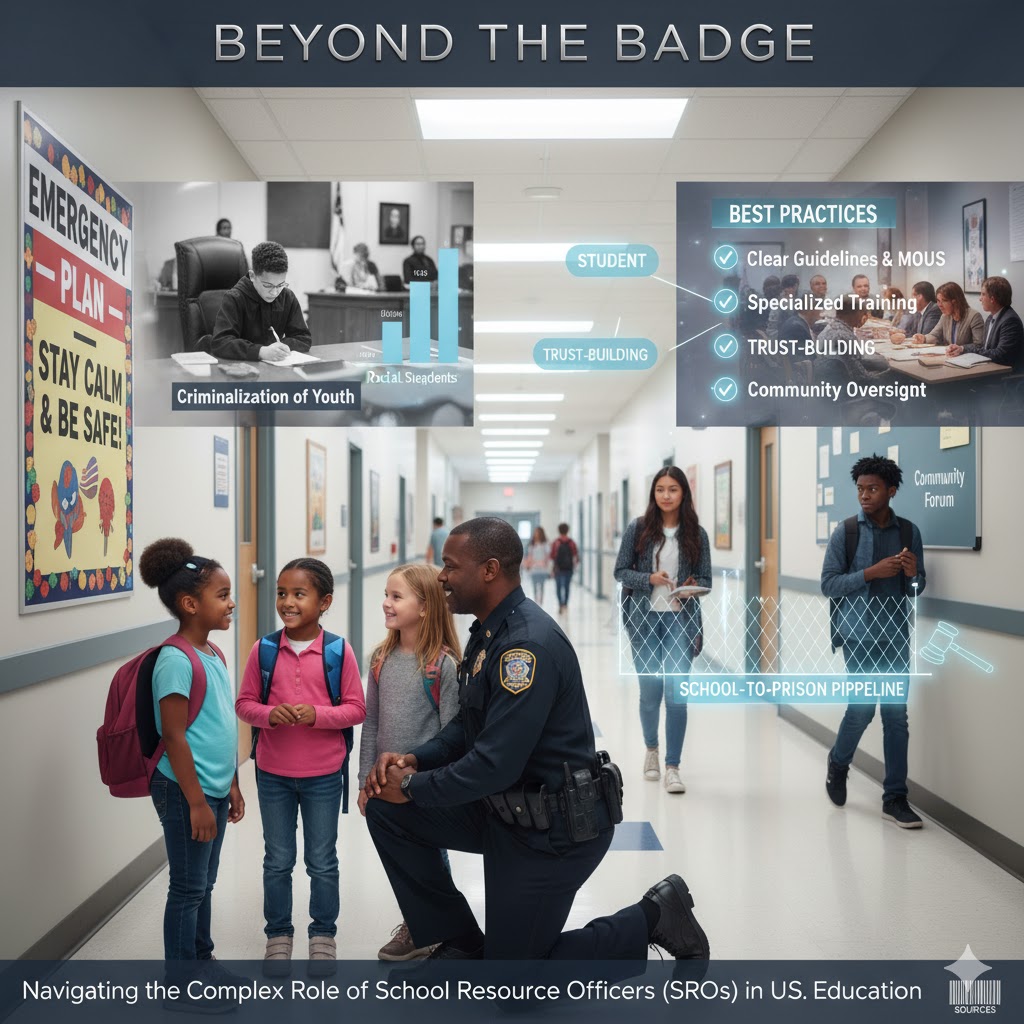Introduction: Understanding the Role of School Resource Officers (SROs)
School Resource Officers (SROs) are sworn law enforcement agents stationed within U.S. schools. Their mission is multifaceted — ensuring safety, mentoring students, and strengthening emergency preparedness. Yet, their presence also transforms the educational environment, raising questions about discipline, equity, and the potential criminalization of youth. Balancing law enforcement objectives with educational values remains a delicate task.
The Multifaceted Role of SROs — Law, Education, Mentorship, and Crisis Response
The SRO is not just a security guard; they hold multiple professional roles:
Law Enforcement
SROs enforce laws on school grounds, investigate crimes, and handle potential threats. They are often first responders to serious incidents.
Educators
They often teach classes or informal sessions on safety, drug prevention, traffic laws, and legal issues, acting as a local source of legal knowledge.
Informal Counselors and Mentors
They are meant to be approachable figures who can build relationships, provide guidance, and connect students with support services, moving beyond just punishment.
Emergency Managers
SROs play a key role in creating and implementing school emergency and safety plans, preparing the community for crises.
Though their presence often helps prevent violence and ensures quick responses to threats, it can shift the focus from education and restorative practices to legal compliance and control.
The Debate — Disparate Impact and the Criminalization of Youth
The debate over SROs is sharp because their presence correlates with negative outcomes, especially for vulnerable student groups.
Increased Disciplinary Actions and System Referrals
Research shows that having SROs often leads to net widening, where minor disciplinary issues escalate to police matters.
Studies indicate that schools with SROs report many more arrests and referrals to juvenile justice for minor offenses compared to those without them.
This blurring of boundaries between educational discipline and criminal enforcement forms a harsh environment where misbehavior that was once managed internally can lead to a student’s first police record.
Fueling the School-to-Prison Pipeline
A significant concern is the impact on students of colour, a major factor in the school-to-prison pipeline.
Disparities in Referral and Arrest Rates
Black Students: Significantly higher risk of SRO referral and arrest than White peers. National data consistently shows that Black students are referred to law enforcement at greater rates for the same or less severe misbehavior compared to their White classmates.
Students with Disabilities: Higher rates of arrest compared to peers without disabilities. They often face more physical restraints, seclusion, and SRO involvement because of behaviours linked to their disabilities.
This racial disparity raises important questions about fairness and equity, suggesting that current SRO practices can reinforce systemic inequality instead of promoting safety for everyone.
Best Practices — Structuring SRO Programs for Success and Equity
To take advantage of the security benefits of SROs while reducing the risks of criminalization and unequal impact, effective programs should have clear structures and oversight:
Clear Guidelines and Memorandums of Understanding (MOUs)
Schools and police departments must create detailed MOUs that specifically limit the SRO’s role in routine school discipline. SROs should only manage issues involving a real safety threat or a legal reporting requirement. Misconduct like truancy, dress code violations, or verbal defiance should remain the responsibility of school administrators.
Specialized Training
SROs need ongoing training in child and adolescent development, de-escalation techniques, implicit bias, and restorative justice. Their training should prepare them for a school environment, not just street policing.
Community and Program Oversight
Strong supervision and cooperation with the community, including students, parents, and civil rights groups, are vital. This ensures accountability, helps officers build trust, and protects students’ constitutional rights.
Focus on Well-being and Mentorship
The emphasis should shift from strict enforcement to mentorship and proactive problem-solving. The goal is to balance security with inclusion, ensuring schools are safe and supportive places for learning rather than environments marked by constant surveillance or exclusion.
Data Transparency
Regular public reporting of SRO-related incidents and outcomes.
Student Voice
Include student feedback in evaluating SRO programs.
Court Judgments and Legal Developments
Recent court rulings have continued to shape the legal boundaries governing School Resource Officers (SROs) and their interactions with students.
Glenn v. Britt (2025, 11th Circuit)
The court upheld summary judgment for officers who restrained a 14-year-old student, ruling that the force used was de minimis and therefore protected by qualified immunity. This decision reaffirmed that minimal or incidental force, even in sensitive school settings, may not rise to the level of a constitutional violation.
S.R. & L.G. v. Kenton County Sheriff’s Office (2015)
The court ruled that handcuffing two elementary school children with disabilities was unconstitutional, underscoring the limits of SRO authority and the need for disability sensitivity training.
Ford v. Richland County (2015)
SRO Ben Fields’ violent removal of a high school student from her desk sparked widespread outrage and his subsequent dismissal, marking a watershed moment in public debate over policing in schools.
Richmond v. Badia (2022, 11th Circuit)
The appellate court denied qualified immunity for the excessive force claim in the related civil suit, allowing the case to proceed. This rare denial signalled that SROs could face accountability when their conduct clearly violates established constitutional rights.
Collectively, these rulings underscore key legal themes — qualified immunity, the de minimis force doctrine, blurred professional boundaries, and disparate impacts on vulnerable student groups — that continue to shape the evolving landscape of school policing in the United States.
Conclusion
The central challenge is not merely whether SROs belong in schools, but how their roles are clearly defined, limited, and aligned with educational values. Structured properly, SRO programs can enhance safety and build trust; without guardrails, they risk undermining equity and the very purpose of education.






